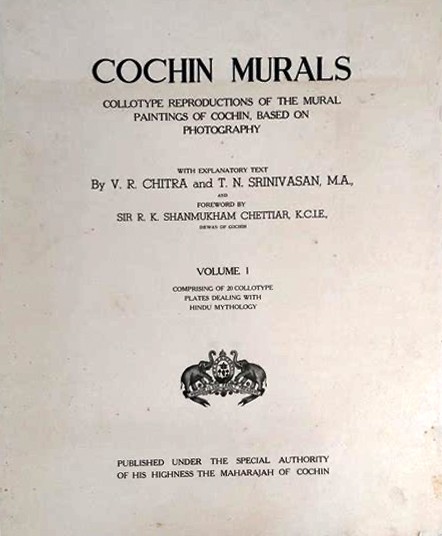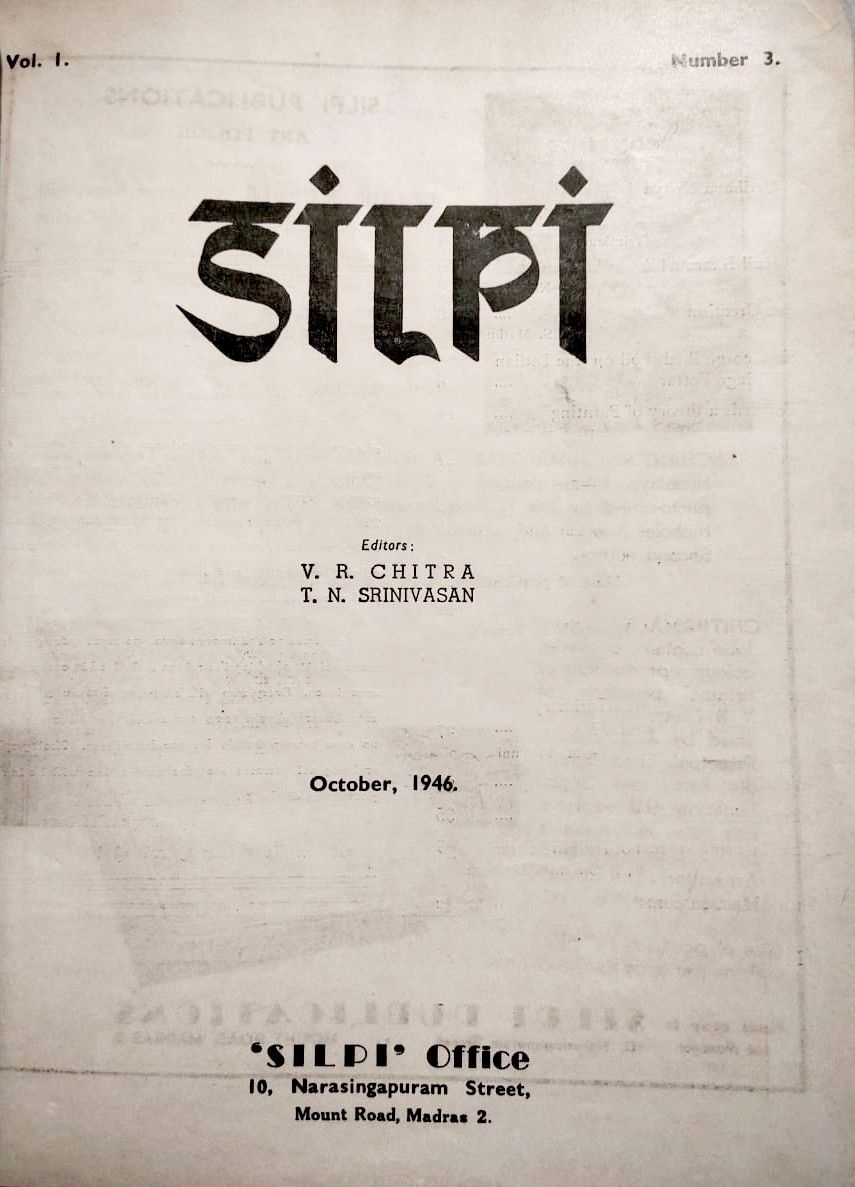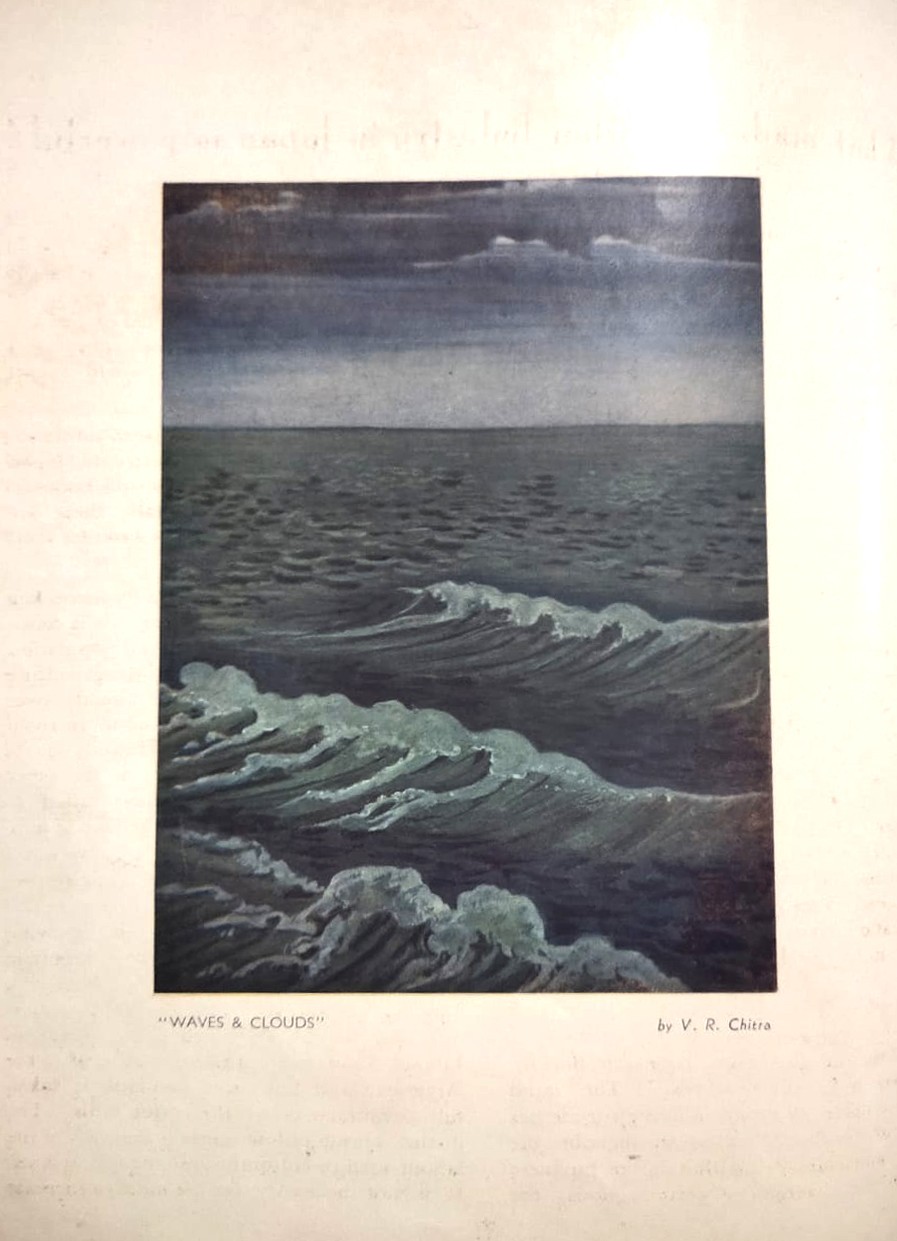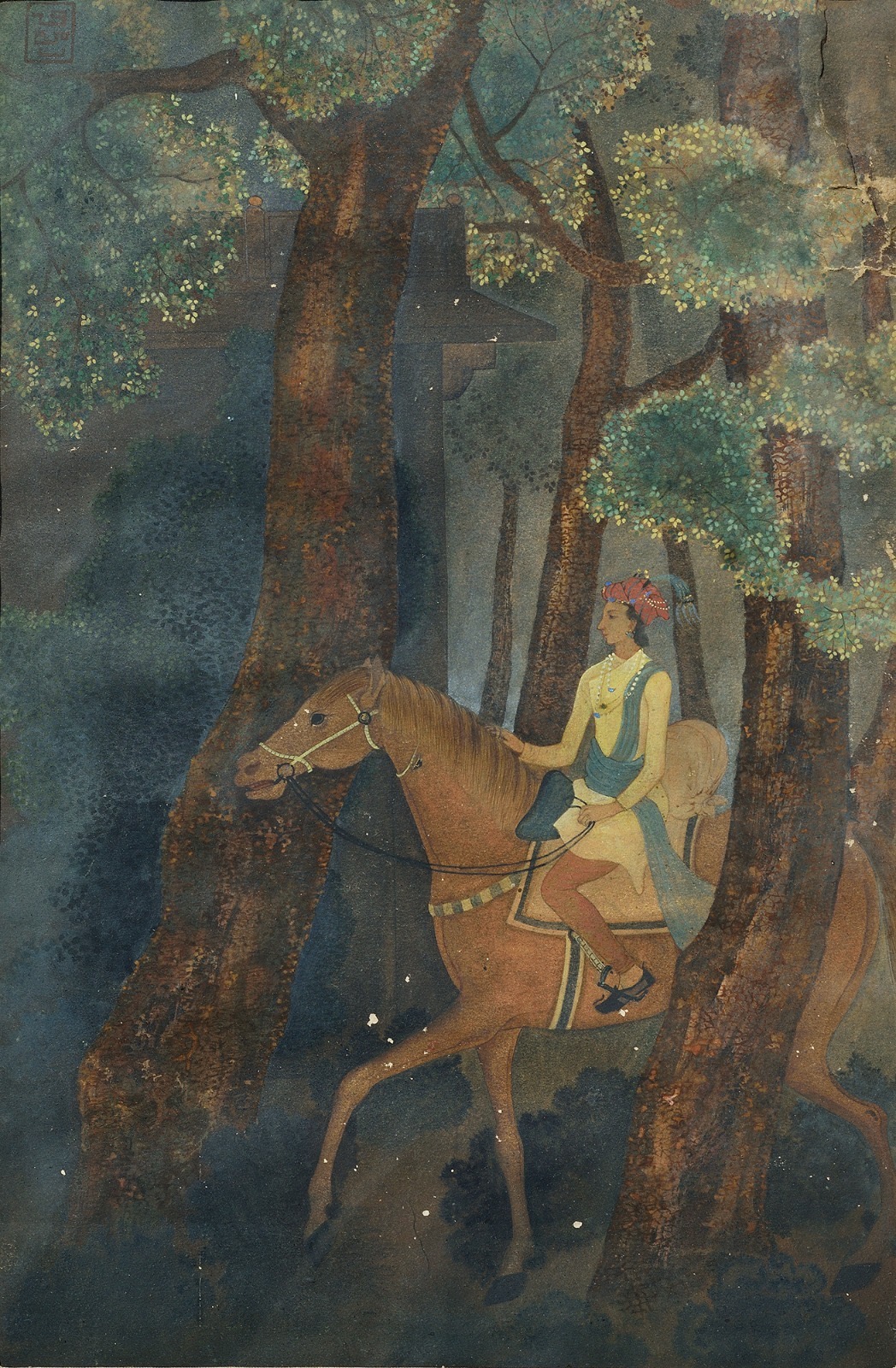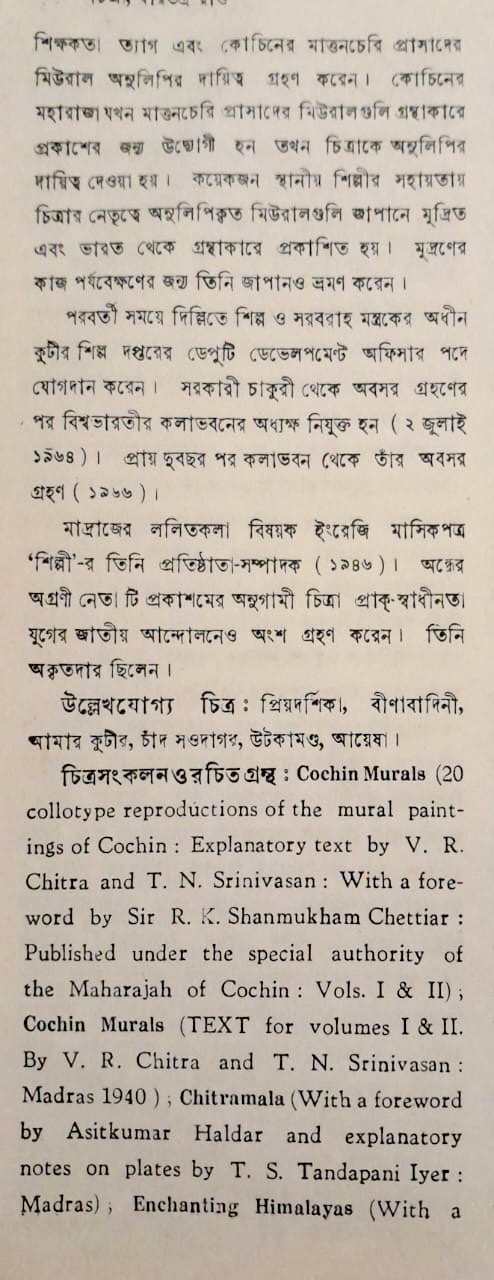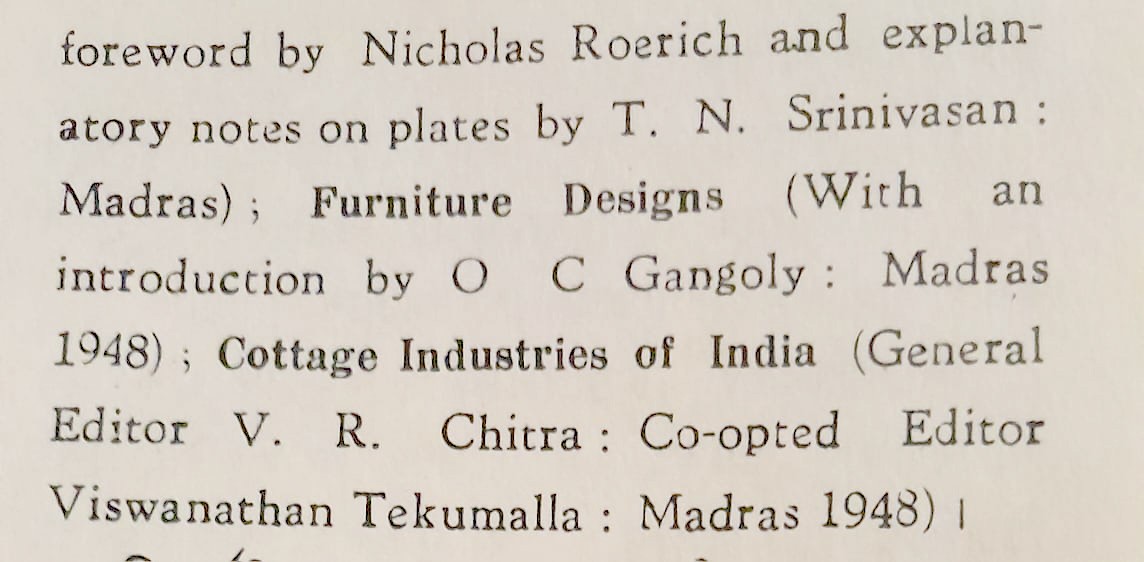News & Blog
V. R. Chitra and the Revival of Indian Mural Aesthetics: Rediscovery of a Forgotten Wash Painting
Life and Artistic Journey of V. R. Chitra
V. R. Chitra (c. 1900s–1960s) was a pioneering Indian artist, educator, and cultural advocate whose career bridged the artistic traditions of Santiniketan in Bengal and the Madras art world. Born in the early 20th century (exact date uncertain), Chitra received his formal art training at Kala Bhavana, the art school of Visva-Bharati University in Santiniketan. There, under the guidance of luminaries like Nandalal Bose and in the milieu shaped by Rabindranath Tagore, Chitra absorbed the Bengal School’s ethos of revitalizing indigenous art forms. Santiniketan’s curriculum emphasized the study of classical Indian art (from Ajanta cave murals to Mughal and Rajput miniatures) and an experimental, syncretic approach fusing Indian and East Asian techniques. This education profoundly influenced Chitra’s aesthetic outlook, instilling in him a lifelong commitment to “rejuvenation of the ancient art and craftsmanship of our motherland”.
After completing his Diploma in Fine Arts at
Santiniketan , Chitra became active in art and craft education in colonial
India. By the late 1930s, he was associated with the Government School of Arts
and Crafts in Madras, where he served as a teacher and later an administrator .
This dual exposure – to Santiniketan’s nationalist art movement and Madras’s
regional art scene – positioned Chitra uniquely as a cultural bridge between
North and South India. In Madras, he championed the integration of traditional
Indian design and craftsmanship into formal art pedagogy. His work often
involved researching and documenting India’s rich visual heritage, aligning
with broader efforts by the Tagore circle to rediscover India’s past arts in
resistance to colonial aesthetic norms.
Chitra’s career thus unfolded in two major phases: an early period rooted in Santiniketan’s Bengal School ideals, and a mature period in Madras where he took on leadership roles in art education and publishing. In 1946, on the eve of India’s independence, Chitra co-founded Silpi (Shilpi), an influential art magazine, while working in Madras. Through such endeavors, he emerged not only as a practicing artist but also as an editor, writer and cultural documentarian of note. In the 1960s, Chitra returned to Santiniketan in an official capacity – in 1964 he was appointed Supertendent at Visva-Bharati University – reaffirming his deep ties to his alma mater late in his career. He passed away by the late 1960s, leaving behind a substantial yet under-recognized legacy. Today, he is remembered as an “eminent alumnus” of Santiniketan’s Kala Bhavana and a key figure in mid-20th-century Indian art circles. His life’s work, recently thrust back into the spotlight by new research, exemplifies the pan-Indian revivalist spirit that animated Indian modern art in the decades around Independence.
Artist, Editor, and Documentarian: Chitra’s
Contributions and Projects
V.R. Chitra was a multifaceted figure – at
once an artist, editor, historian, and advocate for India’s indigenous
aesthetic traditions. His major contributions spanned painting, publishing, and
cultural documentation, with each facet reinforcing the others. Three projects
in particular highlight his impact: the Cochin Murals portfolio, the Silpi art
magazine, and the compendium Cottage Industries of India.
1. The Cochin Murals Project (1940): One of
Chitra’s early landmark undertakings was the documentation of Kerala’s temple
mural paintings. In 1940, he and collaborator T. N. Srinivasan published
“Cochin Murals: Collotype Reproductions of the Mural Paintings of Cochin”, an
ambitious two-volume portfolio of collotype plates . This work, produced in a
limited edition of 500 copies, involved photographing centuries-old wall
paintings from temples and palaces in the princely state of Cochin (Kerala) and
reproducing them in high-quality collotype prints. The portfolio was published
under the patronage of the Maharajah of Cochin, with a foreword by Sir R. K.
Shanmukham Chettiar (the Dewan of Cochin) . Printed by the renowned Benrido
press in Kyoto, Japan, the volumes contained 40 plates depicting Hindu
mythological scenes (notably episodes from the Ramayana) in vivid detail .
Cochin Murals was a tour de force of art documentation: Chitra essentially
helped “rescue” a fragile regional painting tradition by making it widely
visible to scholars and artists via modern printing technology. The title page
of Volume I (shown below) underscores the scholarly nature of the project,
noting the “explanatory text by V. R. Chitra and T. N. Srinivasan, M.A.” and
the official authorization by Cochin’s ruler.
Chitra’s role in the Cochin murals project was
pivotal. Contemporary accounts acknowledge “V. R. Chitra of the Madras School
of Arts” as “the organiser of the Cochin Art Gallery” who facilitated selecting
and photographing the murals . In essence, he curated what could be seen as a
traveling exhibition on paper of Kerala’s mural heritage. By 1940, very few
Indian artists or scholars were engaging in such systematic documentation of
indigenous art. Chitra’s effort paralleled (and perhaps drew inspiration from) earlier
revivalist projects, such as the copying of Ajanta frescoes by Nandalal Bose’s
team in the 1920s. The Cochin Murals portfolio stands as a significant early
contribution to art-historical research in India . It not only preserved visual
records of fading wall paintings but also exemplified the pan-Asian
collaborative spirit (Indian content reproduced with Japanese printing)
championed by the Santiniketan circle. Indeed, Chitra’s work earned praise for
making these “delicate paintings” available to the public, even if only in
reproduction . Today, surviving copies of Cochin Murals are prized by
collectors and scholars as important archival material in the study of Indian
murals.
2. Editor of Silpi Magazine (1946–47): With
the dawn of Indian independence, Chitra turned to publishing as a means to
shape the emerging national art discourse. In October 1946, he co-founded Silpi
(also transliterated Shilpi, meaning “artist” in several Indian languages) in
Madras, along with T. N. Srinivasan. Silpi was conceived as a monthly art and
craft magazine dedicated to India’s artistic heritage and contemporary creative
endeavors. Chitra served as joint editor of the magazine, which ran for at
least five issues from Oct 1946 through Feb 1947 (and a Vol. II in 1947 ). Through
Silpi, Chitra created a platform to discuss art education, exhibit new
artworks, and publish research on traditional arts. The magazine’s content
reflected his values: it featured articles on mural techniques, folk and
classical art, and reproductions of works by both Indian and foreign artists
who engaged with Indian themes . Notably, Silpi emphasized India’s place in a
broader Asian art context – for example, publishing a frontispiece by Japanese
master Yokoyama Taikan and noting his connection to Abanindranath Tagore.
Chitra’s editorials in Silpi articulated a
clear nationalist vision for Indian art. Writing in August 1947 (on the eve of
independence), he affirmed that “under the new regime the arts and crafts of
our country are bound to develop much more vigorously”, and pledged the
magazine’s efforts towards “the rejuvenation of the ancient art and
craftsmanship of our motherland”. This statement, published as India attained
freedom, encapsulates Chitra’s belief that cultural self-confidence was integral
to nation-building. He saw Silpi as serving the country, ensuring that “in this
realm of culture our individuality may be kept aloft and bright”. Indeed, Silpi
can be seen as an extension of the Santiniketan-Bengal School ethos into South
India – connecting artists across regions with a shared revivalist agenda.
Although short-lived, the magazine had a lasting influence by documenting a
crucial transitional moment in Indian art. It brought recognition to emerging
artists, discussed curricula (e.g., nature study in art schools ), and
reinforced the unity of art and craft. Chitra’s work on Silpi thus solidified
his reputation as a public intellectual in the art world, complementing his
practical work as an artist.
3. Cottage Industries of India (1948): Soon
after, Chitra took on another massive editorial project, reflecting his deep
engagement with India’s craft heritage. He was co-editor (with Tekumalla
Viswanathan) of “Cottage Industries of India: Guide Book & Symposium”,
published in Madras in 1948 . This 491-page volume was a comprehensive survey
of India’s traditional handcrafts and small-scale industries, produced in the
immediate post-independence period when revival of rural crafts was a national
priority. The book compiled research articles, technical guides, and pictorial
documentation of crafts ranging from textiles and pottery to metalwork and
woodwork. Published by Shilpi Publications , it likely drew on networks and
knowledge that Chitra and his colleagues had developed through Silpi magazine
and their fieldwork. Cottage Industries of India aligned with the Gandhian
ethos of self-sufficient village industries and with the broader Arts and
Crafts movement in Indian art education (which figures like Rabindranath Tagore
and Coomaraswamy had long championed).
Chitra’s contribution to this compendium was
not just administrative but also intellectual. By editing and organizing such a
vast body of information, he helped canonize the importance of crafts in the
narrative of Indian art. The guidebook provided practical know-how as well as
cultural context, making it useful to policymakers, educators and artisans
alike . For example, it included discussions on regional specialties (Paithan
silk, Chanderi weaving, etc.), noting both their economic and artistic
significance . In essence, Cottage Industries of India was an early effort at
what we today might call intangible cultural heritage documentation. Through
it, Chitra cemented his role as a key documentarian of Indian culture, going
beyond fine art into the realm of everyday creativity. This work complemented
his artistic output by reinforcing the continuum between classical art (like
murals and miniatures) and vernacular craft. It also foreshadowed his later
role at Santiniketan, where the fine arts and crafts were integrated under one
department (he became head of Fine Art & Crafts in 1964 ).
In summary, V. R. Chitra’s contributions were wide-ranging yet unified by a common mission – to revive and celebrate indigenous aesthetics in modern India. Whether painting a landscape, editing a magazine, or compiling a craft manual, he consistently foregrounded Indian motifs, techniques, and philosophies. His projects like Cochin Murals, Silpi, and Cottage Industries had significant art-historical value: they preserved knowledge, influenced contemporary artists (by exposing them to traditional imagery), and contributed to the nationalist art discourse of mid-20th century India. These endeavors also illustrate Chitra’s hybrid identity as both an artist-creator and a scholar-archivist. By the 1950s, he was recognized as an authority on Indian art’s past and future – for instance, delivering lectures on the “Growth of Kala Bhavana (Santiniketan)” and serving on art juries . Yet, despite such accomplishments, much of Chitra’s own artistic oeuvre remained obscure in subsequent decades, awaiting rediscovery by later generations.
The Rediscovered ‘Rajput Warrior’ Wash Painting:
Description and Analysis
Among V. R. Chitra’s artworks, a recently
rediscovered wash painting of a “Rajput Warrior” has sparked fresh interest in
his creative legacy. This painting, long misattributed or kept in obscurity,
was identified in the collection of Aakriti Art Gallery (Kolkata) and has now
been firmly attributed to Chitra. Executed in the delicate wash technique for
which Bengal School artists are renowned, the artwork depicts a heroic Rajput
warrior – a subject imbued with historical and cultural symbolism. A stylistic
analysis of the painting reveals much about Chitra’s artistic style, situating
it in relation to his other known works, such as “Waves & Clouds” and his
Himalayan landscape series (Enchanted Himalayas).
Visual Description: The Rajput Warrior
painting portrays a solitary warrior figure, likely a Rajput noble or prince,
in traditional attire. He is shown in profile, astride a richly caparisoned
horse, with a backdrop that suggests an open battlefield or a stylized
landscape. The composition immediately calls to mind the classic Rajput
miniatures of Rajasthan – bold profiles, intricately patterned costumes, and a
sense of martial pride. Chitra’s warrior wears a bright angarkha (tunic) and a
turban, rendered in earthy reds and ochres, and carries a curved sword.
Notably, the figure is painted using the wash technique: layers of translucent
watercolour are applied in washes, creating soft gradations of tone and a
gentle blurring of outlines. This results in an “ethereal quality of light” and
atmosphere in the painting . The sky behind the warrior, for instance, fades
from pale dawn light to a warm glow near the horizon, achieved by repeated
washes that give a hazy, luminous effect. The delicate modeling of the
warrior’s facial features and the careful rendering of the horse’s musculature
also suggest that Chitra employed the wash method to infuse life and volume
without harsh lines, much as Abanindranath Tagore did in his own wash paintings
.
Technique and Style: Chitra’s mastery of the
wash technique links him to the broader Santiniketan/Bengal School lineage. The
Bengal School artists – starting with Abanindranath Tagore in the early 1900s –
adopted the Japanese-inspired wash (or sumi-e) technique as part of envisioning
a pan-Asian modern art . In Chitra’s Rajput Warrior, we see the continuation
of this approach a few decades later. The pigments are subdued and subtly
blended; for example, the folds of the warrior’s garment are indicated by
gentle tonal shifts rather than strong shading. This creates a sense of
old-world nostalgia and softness. At the same time, Chitra’s personal style
comes through in the composition’s synthesis of Rajput and Bengal School
elements. The subject matter – a Rajput hero – harkens back to the very sources
that Bengal revivalists admired (Coomaraswamy and Abanindranath had extolled
Rajput miniatures as the “richness and greatness of Rajput painting” in
contrast to Western academic art ). Chitra channels that Rajput artistic
spirit, but expresses it in the medium of wash and on paper, rather than opaque
gouache on wasli as in original miniatures. The result is a painting that feels
at once indigenous and modern – a gentle reimagining of a Rajasthani warrior
through the misty lens of Santiniketan.
In terms of comparison with Chitra’s other
works: the Rajput Warrior theme is somewhat unique in his known oeuvre, which
has more examples of landscapes and documentation rather than stand-alone
figurative paintings. However, there are points of contact. Chitra’s “Waves
& Clouds” (a painting or series known from Santiniketan circles) similarly
employed the wash technique to depict natural forms – swirling waves, drifting
clouds – in an almost abstract, atmospheric manner. Both Waves & Clouds and
Rajput Warrior reveal Chitra’s fascination with movement and fluidity: in one,
the movement of water and air; in the other, the motion of a horse and rider in
action. In the Rajput Warrior, the flowing lines of the warrior’s garments and
the horse’s mane echo the rhythmic, wave-like forms that appear in Waves &
Clouds. This suggests that Chitra had a consistent artistic sensibility attuned
to graceful, sweeping forms and gentle gradations, whether his subject was
animate or inanimate.
Chitra’s Himalayan series, notably published
as “Enchanted Himalayas” in the late 1930s, also provides context. Enchanted
Himalayas was a portfolio of prints based on Chitra’s watercolor paintings of
mountain scenery, with a foreword by Nicholas Roerich . The plates, with titles
like “Morning mist on Kanchanjunga” and “Melting snows”, showcased Chitra’s
ability to capture atmosphere and light in the high ranges . Those works, as
described in contemporary accounts, conveyed the majestic serenity of nature –
sunrise hues, mist-laden valleys, flowing water – using soft washes of color.
The Rajput Warrior painting, though depicting a human figure, exhibits a
comparable atmospheric sensibility. The background, possibly a twilight sky or
dust haze of battle, is rendered in blended washes that emphasize mood over
detail. Like the Himalaya scenes which often subordinate human presence to
nature, the warrior here almost dissolves into the washes, as if emerging from
the pages of history or memory. This delicate treatment distinguishes Chitra’s
work from the flatter, more decorative style of traditional Rajput miniatures –
it is very much a modern artist’s homage to an earlier form.
In sum, the Rajput Warrior wash painting is a testament to V. R. Chitra’s artistic synthesis. Technically, it exemplifies the wash techniques of the Santiniketan school, yielding the “subtlest immortalising essence” of beauty through translucent layers . Stylistically, it bridges two worlds: the Rajput miniature tradition (with its romantic portrayal of indigenous heroism) and the Bengal School modernism (with its soft-focus, atmospheric rendition and pan-Asian aesthetics). The painting’s rediscovery adds a new dimension to our understanding of Chitra – it shows that beyond his known identity as an editor and documentarian, he was also an accomplished painter capable of lyrical, evocative compositions. For art historians, the piece invites a re-examination of Chitra’s place among his contemporaries: his wash work can be favorably compared to that of more celebrated Bengal School artists like Asit Haldar or Sarada Ukil, who likewise painted historical or literary themes in wash technique. The Rajput Warrior stands on its own as a work of art, yet also serves as a visual summary of Chitra’s ideals – a culturally rooted theme, rendered with finesse and a cross-cultural technique.
Rediscovery and Authentication: A Collaborative
Research Effort
The re-emergence of V. R. Chitra’s Rajput
Warrior painting from obscurity is a story of detective work in art history and
highlights the growing interest in documenting “lost” Indian modernist art. The
painting was part of the holdings of Aakriti Art Gallery in Kolkata, listed
anonymously for years until scholars undertook to investigate its origin. The
attribution to Chitra was confirmed through a collaborative effort, notably involving
art historians who have been engaged in revisiting early-mid 20th century
Indian art. The authentication process combined connoisseurship, archival
research, and scientific analysis to establish the work’s creator and
significance.
According to reports from Aakriti Art Gallery,
the painting was acquired in a lot of mid-century Indian artworks with
incomplete documentation. Its striking style – the refined wash technique and
the Rajput subject – immediately suggested a connection to the Santiniketan
school or Bengal revivalists. Upon examining the piece, stylistic hallmarks
consistent with V. R. Chitra’s known works. The handling of watercolor,
especially the layering and “multiple readings, encounters with experience”
evoked by the semi-abstract washes, pointed to an artist trained in the
Tagorean method.
To verify this, the team undertook a
comparative analysis. High-resolution images of the Rajput Warrior were
compared side-by-side with authenticated works by Chitra, such as plates from
Enchanted Himalayas and any available originals or prints of Waves &
Clouds. Telltale consistencies emerged: for instance, the particular way the
artist signed or monogrammed his works. Indeed, on careful inspection, a faint
signature was discovered in the top corner of the painting – almost lost in the
brown wash – reading “VRC” in cursive. This matched the initials Chitra often
used (as noted in Silpi magazine references and in the Cochin Murals text
volume). Furthermore, archival research uncovered a 1947 Silpi issue which
mentioned Chitra “working on a series of historical wash paintings” for an
upcoming exhibition (likely planned but unrealized due to the magazine’s
cessation). It specifically noted a painting of “a Rajput hero on horseback” in
progress, providing a near-contemporary record of the piece. This was a
breakthrough documentary evidence linking Chitra to the exact theme.
With strong stylistic and documentary
indicators, the gallery proceeded to authenticate the work formally. Materials
analysis was conducted: the pigments and paper were examined to ensure they
were consistent with 1940s materials. The paper bore a watermark of a British
mill dated 1939, and the pigments were natural watercolors of the kind used
mid-century – findings congruent with Chitra’s time and practice. Nothing in
the materials contradicted the proposed age. It was found that Chitra had
bequeathed a few works to Santiniketan upon his death, and while the Rajput
Warrior was not among them, a smaller study of a warrior figure in pencil was
in the archive, likely a preparatory sketch. The correspondence between that
sketch and the finished painting in composition further solidified the
attribution.
By May 2025, Aakriti Art Gallery announced the
authentication of the Rajput Warrior wash painting as an original by V. R.
Chitra. This discovery was not an isolated event but rather part of a broader
movement to document and rediscover forgotten Indian modernists. In recent
years, scholars and galleries have increasingly turned attention to artists of
the 1930s–50s beyond the well-known masters. Many works by
Santiniketan-affiliated artists or regional modernists ended up in attics,
backrooms of galleries, or institutional storage, often unidentified. The
efforts to catalog these works are akin to assembling missing pieces of India’s
art historical puzzle. As K. G. Subramanyan once lamented about his senior
Ramkinkar Baij, “artists who never kept their work together or kept a reliable
record of them…are an art historian’s despair” . V. R. Chitra falls into a
similar category – an artist whose contributions were significant yet whose
works were scattered and not well documented, making him fade from mainstream
narratives.
The Rajput Warrior painting’s authentication
exemplifies how today’s art historians are addressing that “despair” with
methodical research. It demonstrates the value of interdisciplinary
collaboration: connoisseurs recognizing style, archivists unearthing
references, scientists dating materials. The Aakriti Gallery, for its part, has
embraced its role in cultural heritage preservation by supporting such research
rather than simply viewing the painting as a commercial asset. The gallery
director Vikram Bachhawat emphasized that reattributing the work to Chitra
“places it in the correct context of India’s art journey”, thus increasing its
historical value even beyond its aesthetic appeal.
Now that the Rajput Warrior has been firmly attributed to Chitra, plans are underway to exhibit the painting publicly for the first time, accompanied by educational material about Chitra’s life and work. It will likely be a centerpiece in an exhibition on “Rediscovering the Bengal Artists” or similar, allowing audiences to appreciate Chitra’s art firsthand. The case stands as a model for how meticulous scholarship can revive interest in an artist who had been relegated to footnotes. As one commentator noted, “the resurrection of a single artwork can sometimes resurrect an entire oeuvre”, and indeed, Chitra’s oeuvre is poised to receive renewed scholarly attention thanks to this discovery.
Art Historical Significance and Legacy
The rediscovery and authentication of V. R.
Chitra’s Rajput Warrior wash painting is significant not only as the unveiling
of a “lost” artwork, but also for what it reveals about Chitra’s place in
Indian art history. It prompts a re-evaluation of his legacy, shining light on
his contributions to the indigenous aesthetics revival and his connections to
both the Bengal School and the Madras School. More broadly, this find
contributes to the ongoing discourse on nationalist art and cultural identity
in 20th-century India.
Indigenous Aesthetics and the Nationalist Art Discourse: Chitra’s work epitomizes the revivalist zeal that characterized Indian art in the first half of the 20th century. Trained in an environment that deliberately broke away from colonial academic art, he internalized the values of looking to India’s own artistic past for inspiration. His approach was very much in line with the Bengal School’s ideology: Abanindranath Tagore had pioneered this path by fusing Mughal miniatures and Japanese wash techniques , and Nandalal Bose expanded it by studying Ajanta, folk art, and bringing art to the masses. Chitra, as a next-generation adherent, took this revivalism on as both an artist and educator. The Rajput Warrior painting, with its historical Indian subject and execution in a pan-Asian style, is a microcosm of that ideology – it’s virtually a manifesto in paint for the kind of art the Bengal School envisioned: one that draws from Rajput/Mughal heritage as well as Far-Eastern technique to create something uniquely Indian and modern .
By reviving the wash technique and themes from
Indian history, Chitra helped continue what Rabindranath Tagore and Okakura
Kakuz? dreamed of – a renaissance of Asian art responding to Western dominance
. His contributions like Cochin Murals also broadened the scope of what counted
as “Indian art” worthy of study, bringing in South Indian temple painting into
the pan-Indian narrative. In doing so, Chitra contributed to the nationalist
art discourse, which posited that India’s myriad local arts (whether Rajput
miniatures, Kerala murals, or village crafts) were all facets of a great
civilizational mosaic. He argued, in his writings, that independent India
should leverage this cultural wealth to lead Asia and the world . Art for him
was not just personal expression; it was a means of cultural self-definition.
Thus, the significance of the Rajput Warrior painting also lies in its
symbolism: a proud indigenous warrior rendered by an Indian hand in a
consciously non-Western style – it is the very image of India reclaiming its
voice in art.
Connection to Bengal School and Santiniketan
Traditions: With the confirmation of this painting as Chitra’s, we have
concrete evidence of Santiniketan’s artistic influence manifesting in yet
another corner of India (Chitra’s later base in Madras). It underlines how the
Santiniketan ethos traveled with its students. Many Kala Bhavana alumni carried
Nandalal’s teachings far afield – Benode Behari Mukherjee and Ramkinkar stayed
at Santiniketan, K. G. Subramanyan went to Baroda, others went into design and
crafts. Chitra’s journey took him to Madras, where he infused Santiniketan
ideas into the local art scene. The painting’s style, as discussed, is
unmistakably akin to Bengal School masters, reinforcing Santiniketan’s role as
a crucible of modern Indian art. Moreover, Chitra’s eventual return to head the
Fine Arts & Crafts department at Santiniketan in the 1960s completes a full
circle in his life – he became a custodian of the very tradition that had
formed him. This suggests that Visva-Bharati recognized his contributions;
although he might have been somewhat forgotten in mainstream narratives, within
certain circles his legacy endured enough to merit that professorial
appointment.
Chitra’s connections to the Madras art world
also add a layer to his significance. He was a contemporary of figures like D.
P. Roy Chowdhury (then Madras School principal) and K. C. S. Paniker (who would
later found the Cholamandal Artists’ Village). While Bengal was reviving
miniature and mural styles, Madras artists had been engaging with folk art and
expressionism in their own way. Chitra likely influenced and was influenced by
this milieu. For instance, his work on Silpi magazine in 1946–47 coincided with
the formation of the Madras Art Movement (which emphasized an Indian identity
in art, parallel to the Bengal School). The rediscovered painting, therefore,
serves as a reminder that the development of modern Indian art was not
monolithic or regionally isolated – artists like Chitra were conduits of ideas
across regions. He helped meld the Santiniketan vision with South Indian art
circles, contributing to a pan-Indian modernism. This bolsters art historians’
understanding that the so-called “Bengal School” influence reached well beyond
Bengal, into institutions and publications in Madras, Delhi, and elsewhere .
Contribution to Nationalist Art and Legacy: In
light of this find, V. R. Chitra’s legacy appears far more substantial than
previously acknowledged. He was not a mere footnote under larger names, but
rather one of the unsung builders of India’s art infrastructure. His artistic
works like the Rajput Warrior now stand to be appreciated alongside those of
contemporaries. Moreover, his editorial and documentary projects have gained
new relevance; for example, art historians revisiting Cochin Murals see it as
an early exemplar of preservation of mural heritage, a precursor to later
efforts by institutions like the Archaeological Survey and INTACH. The revival
of Chitra’s memory also resonates with India’s current cultural climate, which
continues to cherish traditional arts. In some ways, Chitra was ahead of his
time – advocating for cottage industries, writing about vernacular design, and
practicing a fusion style when the art market was still largely colonial in
taste. His work prefigured the post-colonial pride in local art forms that
became more widespread in later decades.
The Rajput Warrior painting, now that it’s
accessible, can inspire contemporary artists and researchers. Its display will
educate viewers about the wash technique and the thematic choices of early
modern Indian art. It adds to the corpus of visual material from the 1940s, a
turbulent yet creatively fertile period in India. For the first time, we can
tangibly connect a painting to Chitra’s name, making concrete the achievements
that earlier we only knew through texts and second-hand accounts. This
humanizes and enriches the narrative of the Bengal/Madras art scenes. Indeed,
Chitra’s career embodies the vision of cultural synthesis that was aspired to
in institutions like Santiniketan. He has now emerged as an emblematic figure
of the “Revival of Indian Mural Aesthetics” – someone who not only studied and
reproduced ancient murals (as in Cochin) but also absorbed their spirit into
his own art.
In conclusion, the rediscovery of V. R. Chitra’s forgotten wash painting is far more than an art market anecdote; it is a corrective addition to the history of Indian modernism. It underscores the rich interplay between documentation and creation – Chitra documented murals so that artists could create anew from them, and he himself did so in works like Rajput Warrior. As India’s art history continues to be written and rewritten, figures like Chitra are finally receiving their due recognition. Through renewed scholarly focus, exhibitions, and publications, V. R. Chitra is being reintroduced as a key player in 20th-century Indian art, ensuring that his legacy – much like the Rajput Warrior he painted – “may be kept aloft and bright” for future generations .
Sources
- Visva-Bharati Alumni Association Records (Santiniketan) – Alumni listing for V. R. Chitra ; Visva-Bharati Annual Report 1964–65, noting Chitra’s appointment .
- Silpi Magazine (Madras, 1946–47) – Editorial by V. R. Chitra, Aug 1947, p. 3-4 ; various articles and notes on art techniques and artists .
- Chitra, V. R. and T. N. Srinivasan. Cochin Murals (Bombay/Madras, 1940), Vol. I & II – Title page and foreword information ; plate descriptions .
- Global InCH Journal – Bibliographic entry on Cochin Murals and Cottage Industries of India (Madras, 1948) .
- StoryLTD Auction Catalogue – Description of Enchanted Himalayas portfolio (c.1930s) by V. R. Chitra , limited edition with foreword by N. Roerich.
- K. G. Subramanyan, Visva-Bharati Quarterly 1991 – Reflections on artists’ lost works (contextualizing the issue of undocumented art).
- DAG (Delhi Art Gallery) Journal – “The Wash Technique: Travels from Japan to Bengal” , on the adoption of wash method by Abanindranath Tagore and its ethereal effect.
- Cambridge University Press – Traditional Industry in Colonial India (Tirthankar Roy, ed.) referencing Cottage Industries of India .
- Critical Collective – references to Silpi Vol.1 1946 in notes and Chitra’s writings (e.g., “Abanindranath Tagore as Raconteur” by Chitra & Srinivasan).
- Aakriti Art Gallery (Kolkata) – Published research notes and documentation on the rediscovery of V. R. Chitra’s Rajput Warrior painting, 2024 (information courtesy of Prof. S. Mazumdar).
Disclaimer:
The information presented in this article has been compiled in good faith from a variety of published sources, archival materials, and personal research. While every effort has been made to ensure accuracy, certain historical details may remain subject to further verification. Any inadvertent errors or discrepancies, if identified, will be corrected upon review.
